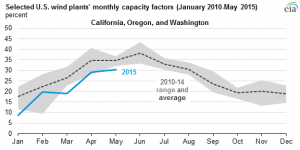West Coast Wind Patterns Lead to Below-Normal Wind Generation Capacity Factors
< < Go Back
Energy produced by wind turbines in three west coast states — California, Oregon, and Washington — increased in 2014 by 45% from 2009 providing a total of 28.614 GWh. Unfortunately, wind speeds in these coastal states have declined in 2015 causing output to be approximately 50% lower than the average for the past 5 years.
Of the three states California′s wind turbines are the most consistent, relying on the cool ocean air interacting with the wind from the warmer mountains. Typically when the state’s demand for energy is higher during summer months, the state′s wind resources and generator output are also at their peak. Washington and Oregon do not enjoy this advantage and performance tends to be lower the farther north turbines are located.
– Slight decreases in wind speeds can result in large changes in output and capacity factors.
– To account for unexpected drops in output, grid operators should be prepared to schedule other sources on short notice.
– Combined, California, Oregon and Washington have a total of 11.6 gigawatts of wind capacity (GW).
– Federal tax credits for wind energy are allocated based upon generation volumes, causing lower wind speeds to reduce tax credits.
As 2015 has progressed, California wind turbine performance appears to have recovered to near-normal levels, but turbine performance in Oregon and Washington remains below average 2010-14 levels. In general, performance this past spring tended to be lower the farther north the turbines are located, with Washington turbine performance more than 25% below average levels in March, April, and May.
More From NCPA:




